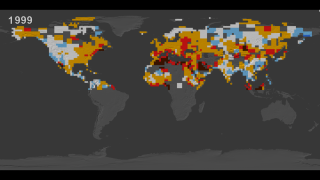Hot Hot Heat
Summers in the Northern Hemisphere are getting hotter. Scientists at NASA's Goddard Institute for Space Studies analyzed temperature data for land in this part of the world and found that extremely hot summers are more likely now than they were 30 years ago. Crop-devastating heat through the summer of 2012, for example, included the hottest month on record for the contiguous United States. Scientists show the rise in likelihood of these events is the result of global warming, a connection that becomes evident in the statistics. The frequency of "hot" (orange), "very hot" (red) and "extremely hot" (brown) summers in the Northern Hemisphere in relation to the average summer temperature determined for the region from 1951 to 1980 can be seen in the visualization. Summers defined as "average" (white), unusually "cold" (light blue), "very cold" (dark blue) and "extremely cold" (purple) are also shown.

Extreme summer heat waves are more likely now than they were in the middle of the 20th century.
Watch how summer temperatures in the Northern Hemisphere change from 1955 to 2011.

Memorable events, such as the 2003 European heat wave, fall into the "extremely hot" category.

The 2006 North American heat wave generated record temeperatures in cities across the United States and Canada.

In 2009, almost 70 percent of land in the region was hotter than average, while 13 percent was unusually cool.

In 2010, extreme heat waves afflicted the Middle East, Western Asia and Eastern Europe.

The 2011 heat waves in Texas, Oklahoma and Mexico would not likely have occurred in the relatively stable climate of the mid-20th century.
For More Information
See NASA.gov
Credits
Please give credit for this item to:
NASA's Goddard Space Flight Center
-
Animators
- Greg Shirah (NASA/GSFC)
- Lori Perkins (NASA/GSFC)
-
Scientists
- James Hansen (NASA/GSFC GISS)
- Makiko Sato (NASA/GSFC GISS)
-
Writer
- Kathryn Hansen (Wyle Information Systems)
Release date
This page was originally published on Tuesday, August 28, 2012.
This page was last updated on Wednesday, May 3, 2023 at 1:52 PM EDT.
